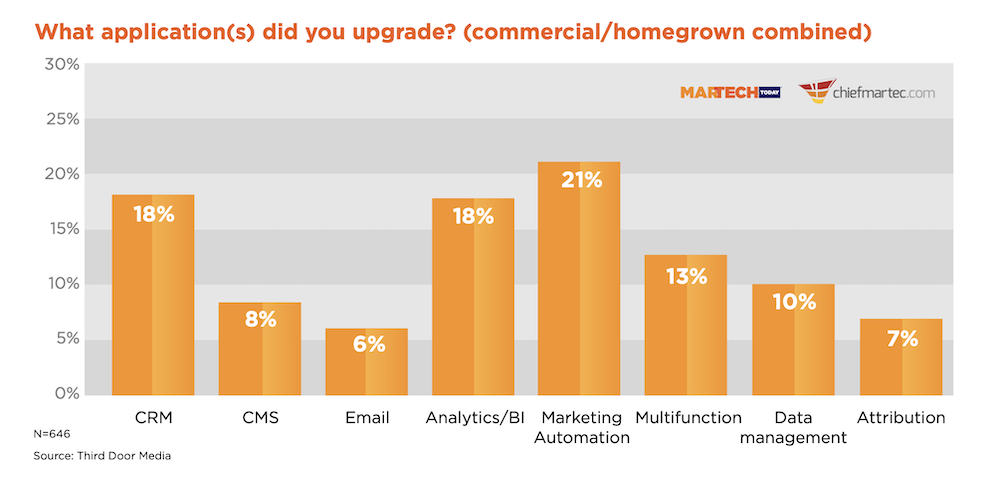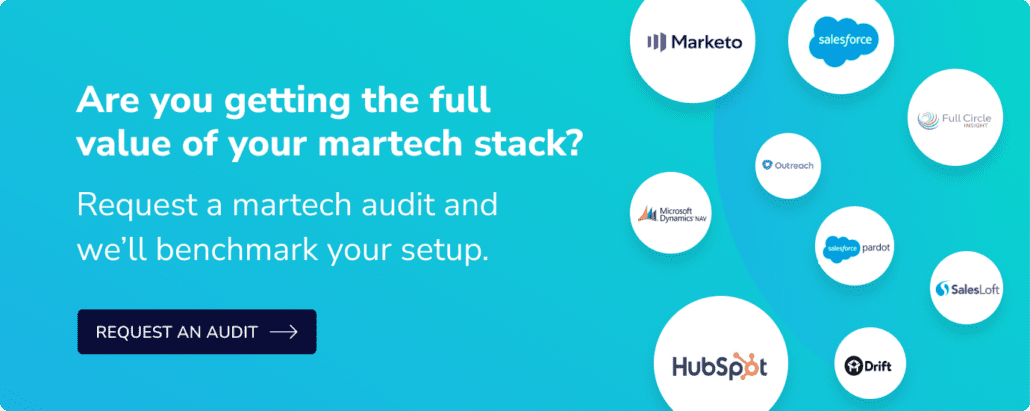83% of marketers rip-and-replace a MarTech app each year. Yes yearly. I was shocked by this — buying MarTech software is a gritty, time-consuming, and distracting project.
So why all the swapping? Here are 11 hard-learned lessons for buying MarTech software for the right reasons.
> Related: Why Marketing Automation Platform Implementations Fail <<
In this post:
1. Think in terms of ROI
There are many costs in migrating:
- overlapping SaaS fees while you spend months implementing and configuring the new tool
- staffing up or hiring out because you don’t have the technical skillset or bandwidth
- fewer demand gen campaigns while transitioning
Your team will also be distracted by vetting a new platform and battling for the budget. They will near burn out from late nights, repetitive training and evangelization, and putting their reputations on the line.
So, will you gain enough efficiency to make the cost worth it? Will you send more campaigns? Will they convert better? Is the sales cycle going to move faster?
2. Think long term
MarTech should be a 3-5 year investment. A lot of us are living quarter-to-quarter, so it’s hard to imagine hitting the ceiling of features, horsepower, or database size. But ask yourself:
- Integrations: Will your mix of channels and tools evolve over the next 3 years? Does this work with your core company platforms?
- Reporting: What five metrics do you care about? Are they evergreen?
- Workflows: What automation is important to you? Do you need to get more sophisticated?
- Staffing: Can you easily hire someone to manage the platform?
- Training: There will be turnover. How easy is it to learn the new platform?
3. Remember you own this tool
At the end of an implementation, marketing teams suddenly find themselves with a lot less budget and a lot more complexity. Make sure you’re not at the whims of a CXO’s casual opinion, pressured by the board to “get something”, or wooed by an aggressive sales rep. There needs to be full-throated support among the marketing team.
Also make sure “owning” it is part of someone’s job description. For example, we estimate it takes 35 hours/month to maintain a MAP.
4. New tech won’t solve a Sales and Marketing alignment problem
Implementations tend to reveal we are more siloed than we think, less organized than we think, and we plan less than they think. New investments (and sky high expectations) only aggravate these issues. Seize the opportunity to address the planning and people problems.
- What are the funnel stages?
- What are the SLAs?
- Are we sharing the same reports?
- Do we agree on the lead scoring threshold?
5. Define user stories before demos
“What exactly do we want to do with this software?” is a surprisingly tough question to answer. Sit down first as a diverse team and write user stories. That way you’ve identified pain points, goals, and necessary compromises before falling in love with a glossy demo.
And remember no tool is a silver bullet; they all have quirks, limitations, blockbuster features, and bad customer support. The question is which limitations can you live with.
Here are 29 sample user stories to help you get started.
6. Be a PITA during demos
Everything looks good in a scripted demo. Go off script as soon as possible, and push your sales rep to show you exactly how to fulfill each user story.
If possible, get access to a sandbox/free trial to solve your toughest campaign or automation problem.
7. IT is your friend
IT can be the unlikely BFF of a marketing team. They have deep expertise in procurement, planning, alignment, and project management. They will help you vet new software and ensure its compliant with your security protocols and GDPR. And by enlisting their help, marketing can spend more time running campaigns and less time color-coding spreadsheets.
8. Treat an implementation like a major campaign
New tech can be as big and consequential a project as a user conference or product launch. Giving the entire project to one person with a distant launch date is a sure way to miss it.
There should be a project plan, milestones with firm dates, sprints, and check-ins. Get the full project checklist here >
And this isn’t a side hustle – it has to be someone’s #1 focus.
9. This isn’t a “learning moment”
It’s pretty rare a MarTech tool works out of the box. You need [talented] staff to implement it and leverage it. If your Marketing, MOPs, or Sales Ops teams don’t have the experience, the learning curve will be steep.
How to know if they’re qualified?
- They’re certified in your new platform.
- They’re obsessed with process and genuinely passionate about automation.
- They know what DKIM is!
10. Don’t over bake the cake
Don’t expect to “get it done” right away — the risk is you’ll never launch. Get the lights turned on. Once your MAP is configured and functional, there’s more bandwidth to learn its features, experiment, and strategize.
Then commit to tackling new things each quarter, because you’re never done building, testing, and troubleshooting.
11. Change is emotional
Change is hard and people are generally not willing to change. Improve adoption by:
- finding the right time to do training (i.e. not at the end of the quarter)
- building in time for office hours and support
- assuming the lowest common denominator for new users
- communicating over and over and over again, especially to partners in IT and Sales Ops
Header image via chiefmartec.com





